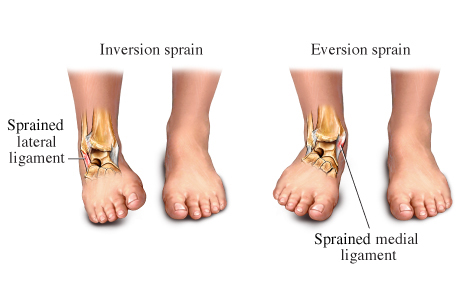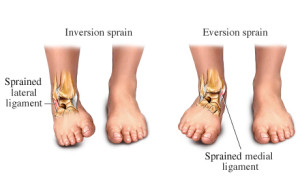Twisted up
Ankle Sprains
So maybe you thought it was a good idea to jump from the roof, or maybe you just stumbled off a step. However it happened, you seem to be left with a sprained ankle. A twisted or sprained ankle is a very common occurrence. When you sprain your ankle, it may feel like you are stuck with it forever! A sprained ankle is a great responsibility, because if you do not take care of it, it may not heal properly.
What exactly is a sprained ankle?
Ankle injuries may present as either sprains, strains, dislocations or fractures. The type of injury will depend on the type of impact suffered. The severity of the injury also depends on the structures that become damaged.
The most common ankle injury is the sprain and the most common type of sprain is an inversion sprain. When you sprain you ankle it means that you have torn or stretched one or more ligaments on the outside of your ankle. When this happens, blood flow to the ankle will increase, white blood cells (that initiate inflammation) will travel toward the injured ankle and fluid will leak from blood vessels into the tissue around the ankle joint. This causes pain, swelling and redness of the ankle. It will be difficult to move your ankle and you may not be able to walk.
For diagnostic purposes, you will need to provide a history of what happened and the possibility of fractures to the ankle will need to be assessed.
The main functions of the ankle are plantar flexion (downward movement) and dorsi flexion (upward movement) of the foot. This means that when you sprain your ankle any movement of the foot becomes almost impossible or simply out of the question. [1][2][3]
How did I sprain my ankle?
Ankle sprains usually happen when excessive force is applied to the ankle ligaments. It can be caused by excessive turning, twisting or rolling of the foot that is frequently caused by an external force. When the foot is moved in a way that is out of its normal movement range this puts strain on the ligaments. The ankle ligaments can compensate for abnormal movement up to a point beyond which the ankle becomes sprained or damaged. Many factors may contribute to the risk of spraining your ankle. Some are intrinsic and some are extrinsic.
Intrinsic factors include:
- Weak ligaments of the ankle joint (hereditary or caused by repetitive overstretching)
- Weakened tendons or muscles around the ankle joint
- Slow neuromuscular response to imbalance
- Distorted sense of joint position
- Underlying anatomical features of the foot and ankle
Extrinsic factors include:
- Running on irregular surfaces
- Wearing shoes that do not have proper heel support
- Wearing high-heels
Accidents can always happen, but it is better to avoid factors that can lead to ankle injury. [4][5][6]
Ankle injuries can vary in severity and three stages are identified. With a grade 1 sprain the ankle ligaments become stretched. If you are diagnosed with a grade 2 sprain the ligament is probably partially torn and stretched. A grade 3 sprain is when the ligaments are ruptured and partially torn. [7]
The impact of a sprained ankle
A sprained ankle is not to be taken lightly, although it is often viewed as a trivial injury. Injuries to the ankle have been proven to diminish a person’s life quality. [8]
If you consider the fact that a sprained ankle makes it impossible for you to walk on the affected foot, it is not surprising that this can be very frustrating. You will need assistance from either crutches or other people to walk or stand, it takes more time to complete your everyday activities and you have to keep immobile for long periods of time! Then there is also the possibility that the ankle will not repair to its pre-injury state, which is quite distressing.
Someone with a sprained ankle can suffer socially, psychologically and even financially. Think about it. You will most likely not be able to attend social events (Your cast may not go well with your evening dress or tuxedo). Some people, who don’t like attention being drawn to them, may feel the pressure of extra attention. You may even become depressed by your situation. Financial consequences may follow as you may not be able to work.
This is also a horrid situation for athletes and sports enthusiasts who will not be able to practice their sport after such injury. When the ankle is injured athletes are prevented from running, jumping, kicking, and changing direction. [12]
Solutions
Prevention is better than cure which means that taking proper care of your sprained ankle may help to prevent long lasting pain and problems with stability. A sprained ankle is a great responsibility. The “RICE” guidelines should be followed as initial treatment.

- Rest
- Icing
- Compression
- Elevation
This will help to decrease or limit swelling and will aid lymphatic and venous draining. [9][10]
Ligament injuries need rehabilitation because without it, injuries are very likely to re-occur and healing may not be complete. The rehabilitation of ankle injuries is crucial in the recovery process. Especially for athletes who want to return to their sports in the same condition as before the injury.
Athletes should only be allowed to return to full activity once they are capable of completing a full practice session without pain or swelling. [11]
Treatment of ankle sprains at Live Active Podiatry may involve joint mobilisation to return displaced bones to their correct orientation, laser, ultrasound, taping, splinting, massage and rehabilitation. [12]
We also assess and diagnose biomechanical dysfunction to determine any intrinsic factors which could lead to ankle sprains. Using this knowledge we treat these conditions with muscular retraining, functional rehabilitation and also use taping and splinting techniques.






